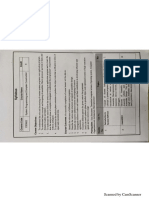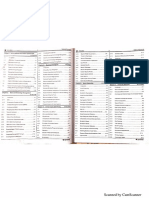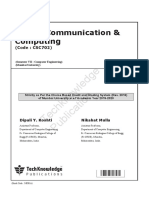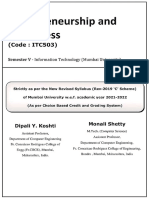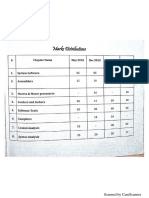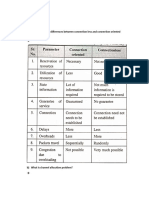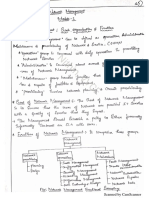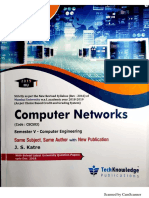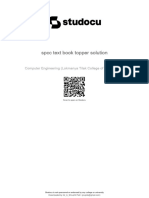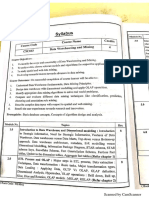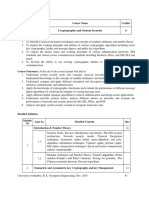0 ratings0% found this document useful (0 votes)
641 views112 pagesMobile Computing Notes Topper Solution
The document provides an overview of Mobile Communication and Computing for BE Computer students, detailing the syllabus, key topics, and the importance of Topper's Solutions for exam preparation. It emphasizes the use of diagrams and point-wise answers for better understanding, alongside various applications of mobile computing in fields like transportation, healthcare, and business. Additionally, it covers fundamental concepts such as frequency reuse, types of antennas, and the electromagnetic spectrum relevant to communication.
Uploaded by
zeel94996Copyright
© © All Rights Reserved
We take content rights seriously. If you suspect this is your content, claim it here.
Available Formats
Download as PDF or read online on Scribd
0 ratings0% found this document useful (0 votes)
641 views112 pagesMobile Computing Notes Topper Solution
The document provides an overview of Mobile Communication and Computing for BE Computer students, detailing the syllabus, key topics, and the importance of Topper's Solutions for exam preparation. It emphasizes the use of diagrams and point-wise answers for better understanding, alongside various applications of mobile computing in fields like transportation, healthcare, and business. Additionally, it covers fundamental concepts such as frequency reuse, types of antennas, and the electromagnetic spectrum relevant to communication.
Uploaded by
zeel94996Copyright
© © All Rights Reserved
We take content rights seriously. If you suspect this is your content, claim it here.
Available Formats
Download as PDF or read online on Scribd
You are on page 1/ 112
Mobile Communication & Computing BE|SEM-7
Topper’s Solutions
Perm See Um) 3) ot
MOBILE COMMUNICATION
; 7
COMPUTING
(BE - COMPUTER) SEM
Aug 2020 Edition
As per Revised Syllabus w.e.f 2019-20
Mobile Communication & Computing BE|SEM-7
TOPPER’S SOLUTIONS
+»In Search of Another Topper
There are many existing paper solutions available in market, but Toppers Solution is the one which
student will always prefer if they refer...) Topper's Solutions is not just paper solutions, it includes many
other important questions which are important from examination point of view. Topper’s Solutions are
the solution written by the Toppers for the students to be the upcoming Topper of the Semester.
It has been said that “Action Speaks Louder than Words” So Topper's Solutions Team works on same
principle. Diagrammatic representation of answer is considered to be easy & quicker to understand. So,
our major focus is on diagrams & representation how answers should be answered in examinations.
Why Topper's Solutions:
“Point wise answers which are easy to understand & remember.
“Diagrammatic representation for better understanding.
* Additional important questions from university exams point of view.
Covers almost every important question.
In search of another topper
“Education is Free.... But its Technology used & Efforts u'
we charge”
It takes lot of efforts for searching out each & every question and transforming it into Short & Simple
Language. Entire Community is working out for betterment of students, do help us.
Thanks for Purchasing & Best Luck for Exams
BACKK BENCHERS
v Handcrafted by BackkBenchers Community ¥
Mobile Communication & Computing BE|SEM-7
The Next Version of Your Life Will
Demand A Different You
~~ By Anonymous.
Mobile Communication & Computing BE|SEM-7
TH] 112] AVG] Term Work | OrallPractical | Endof Exam | Total
Marks | 20 20 | 20 % 5 30 150
# Module Details Contents No.
1. Introduction to introduction to Mobile Computing, Telecammunication | OT
Generations, Cellular systems,
Mobile Computing Electromagnetic Spectrum, Antenna, Signal Propagation,
Signal Characteristics, Muttiplexing, Spread Spectrum: DSSS &
FHSS
= [Cau Mabie GSM Mobile services, Systam Architecture, Radio interface, | 17
Protocols, Localization and Calling, Handover, security (A3, AS
sorvicos Prey
GPRS system and protocol architecture
UTRAN, UMTS core network; Improvements on Core Network
Z| Mobile Networking Medium Access Protocol, Internet Protocol and Transport | 43
layer
Medium Access Control: Motivation for specialized MAC,
Introduction to multiple Access techniques (MACA]
Mobile IP: IP Packet Delivery, Agent Advertisement and
Discovery, Registration, Tunneling and Encapsulation, Reverse
Tunneling, Routing (DSDV, DSR)
Mobile TCP: Traditional TCP, Classical TCP Improvements like
Indirect TCP, Snooping TCP & Mobile TCP, Fast Retransmit/
Fast Recovery, Transmission/Timeout Freezing, Selective
Retransmission
Z| Wireless LocalArea Wireless Local Area Networks: Infrastructure and ad-hoc | 54
Networks Hissin
IEEE 8021: System architecture, Protocol architecture,
Physical layer, Medium access control layer, MAC
management, 802Ia, 802TIb
Wi-Fi security: WEP, ‘WPA, Wireless LAN Threats, Securing
Wireless Networks
HiperLAN 1 & HiperLAN 2
Bluetooth: Introduction, User Scenario, Architecture, protocol
stack.
3 | Mobility Mobility Management: Introduction, IP Mobility, Optimization, | 83
pve
Meneaement Macro Mobility: MIPv6, MIPv6
Micro Mobility: CellularlP, HAWAl, HMIPy6
6 [Long-Term Long-Term Evolution (LTE) of SGPP: LTE System Overview, | 57
Evolution (LTE) of
3GPP
Evolution from UMTS to LTE
LTE/SAE Requirements, SAE Architecture
EPS: Evolved Packet System, E-UTRAN, Voice over LTE (VoLTE),
Introduction to LTE-Advanced
System Aspects, LTE Higher Protocol Layers, LTE MAC layer,
LTE PHY Layer
Self-Organizing Network (SON-LTE), SON for Heterogeneous:
Networks (HetNet), Introduction to 5G
Mobile Communication & Computing BE|SEM-7
Copyright © 2016 - 2020 by Topper’s Solutions
All rights reserved. No part of this publication may be reproduced, distributed, or
transmitted in any form or by any means, including photocopying, recording, or other
electronic or mechanical methods, without the prior written permission of the publisher,
except in the case of brief quotations embodied in critical reviews and certain other
noncommercial uses permitted by copyright law. For permission requests, write to the
publisher, addressed “Attention: Permissions Coordinator.” at the address below.
Contact No: 7507531198
upport@ToppersSolutions.com
Website: www.ToppersSolutions.com
This E-Book is Published Specially for Last Moment Tuitions Viewers
For Video Lectures visit: https://lastmomenttuitions.cot
1| Introduction to Mobile Computing BE|SEM-7
CHAP INTRODUCTION TO MO!
Qi. Explain concept of frequency reuse with clustering
E COMPUTING
Ans: I5M | Dec-19]
FREQUENCY REUSE WITH CLUSTERING:
1. The band of frequency allocated for cellular system use can be reused with different clusters.
2. Clusters are considered as the configuration of cells over which the complete frequency band is
divided,
This configuration of cells is repeated over and over.
4, Frequency reusing is the concept of using the same radio frequencies within a given area, that are
separated by considerable distance, with minimal interference, to establish communication.
5. The frequency reuse factor is defined as1 over the number of cells in the cluster of the system.
6 Considering a cellular system that has a total of S duplex radio channels.
7. If each cellis allocated a group of k channels (k < $) and if the S channels are divided among N cells
into unique and disjoint channel groups of same number of channels, then,
S=kN
8 TheN cells that collectively use the complete set of available frequencies is called a cluster.
9. ifaclusteris replicated M times within the system, the total number of duplex channels or capacity,
C=MKN
=MS
10. Figure 1 represent freauency reuse concept, cells with the same letter use the same set of
frequencies, A cell cluster is outlin:
in blue color and replicated over the coverage area
Figure 1
‘requency Reuse Concept
Jl. In this example, the cluster size N = 7 and the frequency reuse factor is 1/7 (Since each cell contains
one-seventh of the total number of available channels)
12. The capacity is directly proportional to M.
18. The factor N is called the cluster size and is typically 4,7 or 12
14, if the cluster size N is reduced while the cell size is kept constant, more clusters are required to cover
a given area and hence more capacity is achieved from the design viewpint, the smallest possible
value of N is desirable to maximize capacity over a given coverage area.
15. The frequency reuse factor of a cellular system is WN, since each cell within a cluster is assigned 1/N of
the total available channels in the system.
© Handerafted by BackkBenchers Community Page! of 106
1| Introduction to Mobile Computing BE|SEM-7
FREQUENCY REUSE OFFERS THE FOLLOWING BENEFITS:
1. Allows communications within cell on a given frequency.
Limits escaping power to adjacent cells.
Allows re-use of frequencies in nearby cells.
hen
Uses same frequency for multiple conversations.
10 to SO frequencies per cell
Q2. Explain different application of mobile computing
Ans: I5M | Dec-19]
MOBILE COMPUTING:
1. Mobile computing is human-computer interaction technique.
2. Itisa technology that allows transmission of data, voice and video via a computer or any other wireless
enabled device without having to be connected toa fixed physical link
3. Mobile computing involves mobile communication, mobile hardware, and mobile software.
APPLICATION OF MOBILE COMPUTING:
1) Vehicles:
1. Mobile computing can be used for transmission of news, road condition, Weather, Music via Digital
Audio Brozdcasting (DAB)
2. It. can also be used for Personal communication using GSM.
3. if we forget the road then we can know our exact location with the help of global positioning
system (GPS).
4, In caseif got accident then we can inform police and ambulance via an emergency call to the service
provider, which help to improve organization and save time & money.
5. Vehicle data (e.g,, from busses, high-speed trains) can be transmitted in advance for maintenance.
ll) Emergencies situation & Disaster Rellef:
1. Abllity to receive information on the move is vital where the emergency services are involved.
2. Information regarding the address, type and ather details of an incident can ke dispatched quickly,
via a Cellular Digital Packet Data (CDPD) system using mobile computers, to one or several
appropriate mobile units, which are in the vicinity of the incident.
3. During nature disasters such as earthquakes, tsunami, flood, and fire; only wireless communication
works.
ll) Ue in Business:
1. Mobile Computing can be used in business such as M-Commerce, M-Banking, Advertising ete.
Managers can use mobile computers in, say, and critical presentations to major customers
They cen access the latest market share information.
hwo
At a Business Discussion can be done using video conference any small recess, they can revise the
presentation to take edvantage of this information.
© Handerafted by BackkBenchers Community Page 2 of 106
1| Introduction to Mobile Computing BE|SEM-7
1
They can communicate with the office about possible new offers and call meetings for discussing
responds to the new proposals.
Therefore, mobile computers can leverage competitive advantages.
Health Care:
Mobile medical care, whether in-home, on the road, of within a hospital, is more efficient with mobile
computing.
The mobile healthcare worker can access patient records for reference purposes, and isable to update
records with current diagnosis and treatment information.
Emergency medical technicians (EMTs) responding at the scene of an accident can use mobile
computers to capture patient information, treatments accomplished vital signs, and other critical
data
This information is wirelessly transmitted tothe receiving hospital, which then prepares to receive and
treat the patient, or recommend another hospital facility with more appropriate treatment facilities
depending upon the nature and severity ofthe injuries.
Credit Card Verificatior
At Point of Sale (POS) terminals in shops and supermarkets, when customers use credit cards for
transactions, the intercommunication is required between the bank central computer and the POS
terminal.
In order to effect verification of the cerd usage, can take place quickly and securely over cellular
channels using a mobile computer unit.
This can speed up the transaction process and relieve congestion at the POS terminals.
Transportation and Shipping:
Using mobile computers in conjunction with GPS/GIS and an accompanying vehicle information
system (VIS), the operations of an entire transportation fleet can be managed from a central location
The central office knows the location, status, and condition of all vehicles, and operators have two-way
communication with the operations center.
Using this information, vehicles can be optimally dispatched to maximize efficiency as measured by:
{a) time; (b] fuel consumption; and (c) delivery priority.
The mobile computers enable significant performance improvements, achieved simultaneously with
operational cost reductions.
© Handerafted by BackkBenchers Community Page 3 of 106
1| Introduction to Mobile Computing BE|SEM-7
-- EXTRA QUESTIONS --
an antenna? Explain different types of antennae
Ans: [P| Medium]
oRwM
An antenna is a transducer that converts radio frequency (RF) fields into alternating current or vice
versa.
There are both receiving and transmission antennas for sending or receiving radio transmissions.
Antennas play an important role in the operation of all radio equipment.
They are used in wireless local area networks, mobile telephony and satellite communication.
Antennas can be Omni-directional, directional or arbitrary.
‘TYPES OF ANTENNA:
app
Rw&No
Isotropic Antenna:
Isotropic Antenna is said to be the type of antenna which radiates equally in all directions,
This type of antenna is considered to be ideal antenna.
thas a perfect 360 degree spherical radiation pattern.
There is no actual physical isotropic antenna.
However, an isotropic antenna is often used as a reference antenna for the 9.
The antenna gain is often specified in dBi, or decibels aver isotropic.
This is the power in the strongest direction divided by the power that would be transmitted by an
isotropic antenna emitting the seme total power.
Figure 12 represents radiation pattern of isotropic antenna.
Y
Figure 1.2: Radiation Pattern of Isotropic Antenna
Dipole Antenna:
Dipole antenne is also known as doublet.
It is the simplest and most widely used class of antenna
The dipole is the prototypical antenna on which a large class of antennas are based.
Abasic dipole antenna consists of two conductors (ususlly metal rods or wires) arranged symmetrically,
with one side of the balanced feed line from the transmitter or receiver attached to each.
The length of the dipole is half of the wavelength of the signal.
Hertzian dipole is most commonly used dipole antenna.
Figure 13 represents Radiation pattern of Hertzian dipole.
© Handerafted by BackkBenchers Community Page 4 of 106
1| Introduction to Mobile Computing BE|SEM-7
Figure 1.3: Radiation pattern of Hertzian Dipole (side view)
Ill) Monopole Antenna:
1. Amonopole antenna is a class of radio antenna consisting of @ straight rod-shaped conductor.
lis often mounted perpendicularly over some type of conductive surface, called a ground plane.
It is also known as Markoni Antenna
hep
‘The length of the monopole is one fourth of the wavelength of the signal
Figure 14 represents ideal vertical monopole antenna.
ale
Figure 1.4: Ideal Vertical Monopole Antenna
IV) Antenna Arrays:
1. Array antennas consist of multiple antennas working as a single antenna
2. Typically they consist of arrays of identical driven elements, usually dipoles fed in phase. giving
increased gain over that of a single dipole.
Different diversity schemes are possible.
One such scheme is selection diversity, where the receiver always uses the antenna element with the
largest output
5. The other type of diversity is diversity combining, in which a combination of power of all the signals is
taken to produce gain
6. Figure 15 represents antenna arrays.
Figure 15: Antenna Arrays
© Handerafted by BackkBenchers Community Page 5 of 106
1| Introduction to Mobile Computing BE|SEM-7
V) Loop Antenna:
1. Loop antennas consist of a loop (or coil) of wire.
2. There are essentially two broad categories of loop antennas: big loops and small loop.
3. Loops with circumference of a wavelength are naturally resonant and act somewhat similarly to the
half-wave dipole.
4, Figure 16 represents Loop Antennas.
Figure 1.6: Loop Antenna
V1) Aperture Antennas:
1. Aperture antennas are the main type of directional antennas used at microwave frequencies and
above
2. They consist ofa small dipole or loop feed antenna inside a three-dimensional guiding structure large
compared to a wavelength, with an aperture to emit the radio waves.
3. Since the antenna structure itself is non-resonant they can be used over a wide frequency range by
replacing or tuning the feed antenna.
4, Figure 17 represents aperture antenna.
Figure 1.7: Aperture Antenna
Q2. _ Drawand Explain Electromagnetic Spectrum for communication.
Ans: [P| High]
ELECTROMAGNETIC SPECTRUM FOR COMMUNICATION:
1. The electromagnetic spectrum is the range of frequencies {the spectrum) of electromagnetic
radiation and their respective wavelengths and photon energies.
2. Itis nothing but a characteristic distribution of electromagnetic radiation emitted or absorbed by that
particular object.
When electrons move, they create electromagnetic waves that can propagate through free space.
4 All modern communication depends on manipulating and controlling signals within the
electromagnetic spectrum.
The electromagnetic spectrum ranges from extremely low-frequency radio waves of 30Hz to high-
frequency cosmic rays of more than 10 million trillion Hz.
© Handerafted by BackkBenchers Community Page 6 of 106
1| Introduction to Mobile Computing BE|SEM-7
6 The electromagnetic spectrum as demonstrated in Figure 11, can be expressed in term of wavelength,
frequency, or energy.
Wavelength (A), frequency (v) are related by the expression: A= ¢/v
The higher the frequency, the higher the energy.
Therefore, in communication systern, smaller cerrier Wavelength represent Higher Bandwidth
‘ves) 10210? 10 10° 10% _107__1o"_10?_10" 10% 10% 10! 10% 1049
Cameron su [ey
ke +l + oj}
Fowerand lepine Radio Microwave Tatar
oan pct atin ices tar tae
hte Pa batt
+ consi Cable .| ‘i
Nea
NaSee* 108 107 104 107 10? 10! 10? 10! 102103 104 10% 106
Figure 1.8: Electromagnetic Spectrum for communication
Band Full Forms) Frequency Range Propagation Uses
ELF | Extremely Low | 30- 300Hz Ground Power line frequencies
Frequency
TF [Low Frequency | 3-300 KHz Ground Marine Communications,
communication over
twisted pair
MF | Medium ‘300KHz -3MHz Sky ‘AM radio, communication
Frequency over coaxial cables
HE | Aigh 3— 30 MHz Shy Aircraft and ship
Frequency communications
VHF _ | Very High 30-300 MHz ‘Sky and Line— of- Sight | FM radio, TV
Frequency
UHF | Ultra High 300 MHz-3GHz _ | Line-of- Sight TY, cellular phone
Frequency
SHF | Super High 3-30GHz Line -of- Sight Satellite, microwave links
Frequency
EHF | Extremely High | 3- 300GHz Line oF - Sight Radar, satelite
Frequency
Infrared [infrared Rays | 300Ghz— 400TH? | Line of - Sight Consumer electronic
goods
Visible | Visible Light | 400 THz-SO0 THz | Line-of- Sight Fiber optic
Light | rays communications
© Handerafted by BackkBenchers Community Page 7 of 106
1| Introduction to Mobile Computing BE|SEM-7
Q3. Spread Spectrum?
Ans: [P| Medium]
SPREAD SPECTRUM:
1. Spread Spectrum is an important form of encoding for wireless communications.
2. Spread-spectrum techniques are methods by which a signal generated with a particular bandwidth is
deliberately spread in the frequency domain.
3, Itresults ina signal with a wider bandwidth
4. Itinvolves spreading the bandwidth that is needed to transmit the data.
a serotenaeraee
Figure 1.9: Spread Spectrum: Spreading & Despreading.
STEPS:
1. The process of Spreading & Despreading is shown in Figure 19.
2. An idealized narrow band signal is transmitted by the sender as shown in Figure 1.9 (a)
3, The narrow band signal is converted into broadband signal ie. signal is spread as shown in Figure 19
(0)
4, The energy needs to transmit the signal is still the same.
5. During transmission, narrow band as well as broadband interference gets added to the spread signal
as shown in Figure 19 (¢).
6. The receiver now has to de spread the received signal.
7. The original broadband signal (containing user data) is converted back to a narrowband signal.
8 The narrowband interference that was added is spread whereas the broadband interference is left as
itis.
9. The signal is now applied to @ band pass filter that cuts off the frequencies to the left and right of the
narrowband signal as shown in Figure 1.9 (e)
10. The original user signal can now be recovered
ADVANTAGES:
1. It provides the resistance to narrowband interference.
2. Itis used in military application.
3. Cross-talk elimination
© Handerafted by BackkBenchers Community Page 8 of 106
1| Introduction to Mobile Computing BE|SEM-7
4, Better security & Reduction in noise.
DISADVANTAGES:
1. Increased complexity of the sender and receivers.
2. It requires large frequency band.
4 Explain DSss?
Ans: [P| Medium]
Dsss:
DSSS stands for Direct Sequence Spread Spectrum.
It is also known as Direct Sequence Code Division Multiple Access (DS-CDMA).
It is one of two approaches to spread spectrum modulation for digital signal transmission over the
airwaves,
4, Indirect sequence spread spectrum, the stream of information to be transmitted is divided into small
pieces.
5. Each of which is allocated across to a frequency channel across the spectrum.
6. Adata signal at the point of transmission is combined with a higher data-rate bit sequence (also known
as a chipping code) that divides the data according to a spreading ratio.
7. The redundant chipping code helps the signal resist interference and also enables the original data to.
be recovered if data bits are damaged during transmission.
& Figure 110 and 111 shows DSSS Transmitter & Receiver.
Ds Spreader
Binary Data Modulator
(ePsk)
Pseudo noise bit
Laeeeeeteeneeeeeendfeeee
Figure 1.10: DSSS Transmitter
Demodulator Binary Data
(ersk) ———
Pseudo nolse bit
Figure 1.11: DSSS Receiver
© Handerafted by BackkBenchers Community Page 9 of 106
1| Introduction to Mobile Computing BE|SEM-7
EXAMPLE:
1. 10-bit spreading code spreads signal across 10 times bandwidth of 1 bit code
2. One method: Combine input with spreading code using XOR
a. Input bit 1 inverts spreading code bit
b._ Input zero bit doesn't alter spreading code bit.
Lr aa
Recevedsiont “LF LF L_JL] LJ
SS ornariinn.
I J |
1. Thissystem has very high dearee of discrimination against the multipath sianal. Therefore, interference
called by multipath reception is minimized successfully.
2. The performance of DSSS system in presence of noise is superior to other system such as FHSS system,
3. This system combats the intentional interference (jamming) most effectively.
DISADVANTAGE OF Dsss:
1. With the serial search system, the acquisition time is too large this makes DSSS system slow.
2. The sequence generated at the PN code generater output must have high rate. The length of such
sequence noeds to be long enough to make the sequonce truly random.
3. The channel bandwidth required is very large, but this bandwidth is less than that of FHSS system.
4, The synchronization is affected by the variable distance between the transmitter and receiver.
© Handerafted by BackkBenchers Community Page 10 of 106
1| Introduction to Mobile Com}
puting
BE|SEM-7
Q5. Explain FHSS?
Ans:
EHSS:
FHSS stands for Frequency
Hoped Spread Spectrum.
another in a "hop" sequence,
4. Hence, a hopping pattern can be observed in the spectrum,
FHSS is for instance used by Bluetooth.
It is a spread spectrum technique used in radio transmission systerns.
[P| Medium]
In a FHSS systems the data is sent using a transmission frequency that moves fiom one frequency to
6. FHSS Is defined In the 2.4 GHz band and operates in around 79 frequencies ranging from 2.402 GHz to
2.480 GHz.
7. In FHSS, users are made to change the frequencies of usage, from one to another in a specified tme
interval, hence called as frequency hopping.
was previously used by sender 1,
10. Thisis called as frequency reuse
For example, a frequency was allotted to sender 1 for a particular period of time.
Now, after a while, sender 1 hops to the other frequency and sender 2 uses the first frequency, which
I. The frequencies of the data are hopped from one to another in order to provide a secure transmission.
12, The amount of time spent on each frequency hop is called as Dwell Time.
18. Figure 112and 113 shows FH!
ISS Transmitter & Receiver.
FH spreader
: spread spectrum
Binary Dats Tomuma| St | signal
eet / eendpasre | —
em fm
J[ Frequency |}
Syntesizer_||
Powe noise be i
source channel Tabe |}
Figure 1.12: FHSS Transmitter
FH Despread
sprend spactrurn
Stone! Binary Data
Bandpass Filter —— ~
zm om ce] (escor8Psi)
Pseudo olsebit
souce Channel Table
Figure 1.13: FHSS Receiver
© Handerafted by BackkBonchers Community Pagel of 106
1| Introduction to Mobile Computing
BE|SEM-7
EXAMPLE:
1. In a frequency-hopping spread spectrum (FHSS) system, the transmitted signal is spread across
multiple channels, as shown below.
2. Inthe example, the full bandwidth is divided into 8 channels, centered at fl through f8.
3. The signal "hops" between them in the following sequence: f5, £8, 3, £6, 1.7, 4, £2.
Energy
sa371462
pibidi titi titi
Frequency
ht
fe
See
hs
he
he
fe
hh
1
hhhhh leh te
Frequeney
(a) Channel assignment
Time
(b) Channel ase
Qs.
Compare FHSS & DSSS
Ans:
COMPARISON BETWEEN FHSS AND DSSS/CDMA:
[P| Medium]
FHSS
Dsss /CDMA
Multiple frequencies are used.
Single frequency is used,
Hard to find the user's frequency at any instant of
time.
User frequency, once allotted is always the same,
Frequency reuse allowed.
Frequency reuse is not allowed.
‘Sender need not wait.
Sender has to wait if the spectrum is busy.
Power strength of the signalis high.
Power strength of the signal i Iow.
Stronger and penetrates through the obstacles,
Tris weaker compared to FHSS.
Tels never affected by interference,
Tecan be affected by interlerence,
Tels cheaper,
Tris expenswe,
This is the commonly used technique,
This technique is not frequently used,
© Handerafted by BackkBenchers Community
Page 12 of 106
1| Introduction to Mobile Computing BE|SEM-7
Ans: [P| Medium]
1. 3G Stands for Third Generation Cellular Systems.
2. Itis the third generation of wireless mobile telecommunications technology.
3. It satisfies International Mobile Telecommunications -2000 standard.
4, Itis the upgrade for 2G and 2.5G GPRS networks, for faster internet speed.
4G uses Cireult switching for voice communication, and Packet switching for Date Communication.
6. 3G finds application in wireless voice telephony, mobile internet access, fixed wireless interet access,
video calls and mobile TV.
FEATURES:
Enhanced audio and video streaming
2. Videoconferencing support.
3. Web and WAP browsing et higher speeds.
4, The transfer rate for 3G networks is between 128 and 144 kbps (kilobits per second) for devices that are
moving fast, and 364 kbps for slow ones.
36 offers greater security features than 2G like Network Access Security, Network Domain Security,
User Domain Security and Application Security.
3G ARCHITECTURE:
Rado Access Network Core Network
Packet switch Domain
Mobile Station Circuit switch Domain
05K: Service GPRS support Node
GSN: Gateway GPRS Support Node
GSC: Gateway Mobile Switching Center IMS-1P Multimedia Systern
Figure 1.14: 3G Network Architecture Model
The Constituent parts of 3G UMTS network ere:
1) Mobile station:
1. It could be anything like data and voice-enabled mobile phones, tabs or computers which could be
used as an end user.
© Handerafted by BackkBenchers Community Page 13 of 106
1| Introduction to Mobile Computing BE|SEM-7
ll) RAN (Radio Access Network):
1. It consists of base stations and radio access controller which bridges the gap between Mobile Station
and Core Network.
2. Italso controls and manages the air interface for the whole network,
Il) CN (Core Network)
1._ It provides the main processing and management of subsystems,
2. The 3G UMTS network Architecture is migrated from GSM with some enhancements in core network
elements.
The core network is divided into two parts ie. Circuit Switched Domain and Packet-switched domain.
1) Circuit switched Domain:
1. It uses Circuit Switched Network in which dedicated link or channel is provided for a particular tme
slot to set of users.
2, The two blocks shown in Circuit Switched Dornain are:
a. MSC: Mobile Switching Centre manages circuit switched calls.
b. GMSC: Gateway MSC actsas an interface between external and internal networks.
Il) Packet Switched Domain:
1. Ituses IP Network where IP's are responsible for transmitting and receiving data between two or more
devices
2. The two blocksshown in Packet Switched Domain are:
@. SGSN (Serving GPRS Support Node): The various functions provided by SGSN are mobility
management, session management, billing, interaction with other areas of the network
b. GGSN (Gateway GPRS Support Node): It can be considered asa very complex router and handles
the internal operations between the external packet switched networks and UMTS packet switched
network.
IMS (IP Multimedia Subsystem): It is an Architectural framework which delivers IP multimedia services.
ADVANTAGES OF 3G:
1 It uses 2G frequency bands with bandwidths up to 230MHz ate used to achieve global
roaming and multi-services.
2. Wideband radio channel to support high-speed services.
3. Radio carrier channel uses bandwidth up to 20M which improvises chip rate and anti-multipath fading
4, To improve the performance of the dewnlink transmission channel, fast closed loop power control
technology is applied
© Handerafted by BackkBenchers Community Page 14 of 106
1| Introduction to Mobile Computing BE|SEM-7
Q8. Explain in detail 4G Architecture.
Ans: IP | Medium]
4G:
1. 4G Stands for Fourth Generation Cellular Systems.
2. 4Gis the evolution of 3G to meet the forecasted rising demand.
3. It is an integration of various existing technologies including GSM, GPRS, CDMA one, IMT-2000 and
Wireless LANs.
4, Data rates in 4G systems will range from 20 to 100 Mbps.
FEATURES:
1. Fully IP Based Mobile System.
2. It supports interactive multimedia, voice, streaming video, internet and other broadband services.
2. thas better spectral efficiency.
4, Itsupperts Adhec and multi hop networks,
4G ARCHITECTURE:
1. Figure 115 shows the 4G Generic Mabile Communication Architecture.
2. As shown in figure 116, the 4G Network is an integration of all heterogeneous wireless access network
such as Adhog, cellular, hotspot and catellite radio component.
3. Technologies Used in 4G are Smart Antennas for multiple - input and multiple - output (MIMO), IPv6,
VolP, OFDM and Software Defined Radio (SDR) System.
Figure 115: 4G Generic Mobile Communication Architecture.
‘Smart Antennas:
1. Smart Antennas are Transmitting & receiving antennas.
2. Itdoes nat require increase power or additional frequency.
© Handerafted by BackkBenchers Community Page 5 of 106
1| Introduction to Mobile Computing BE|SEM-7
IPv6 Technology:
1. 4G uses IPvé Technology in order to support a large number of wireless enabled devices.
2. Itenables anumber of applications with better multicest, security and route optimization capabilities.
1. It stands for Voice over IP.
2. Itallows only packets (IP) to be transferred eliminating complexity of 2 protocols over the same circuit,
FDI
1. OFDM Stands for Orthogonal Frequency Division Multiplexing.
2. Itis currently used as WiMax and WiFi
sD
1. SDR Stands for Software Defined Radio
2. [tis the form of open wireless architecture,
ADVANTAGES:
1. It provides better spectral efficiency.
2. Ithas high speed, high capacity and low cost per bit.
DISADVANTAGES:
1. Battery usage is more.
2. Hard toimplement.
© Handerafted by BackkBenchers Community Page 16 of 106
2 GSM Mobile Services BE|SEM-7
CHAP GSM MOBILE SERVICES
Qi. Explain in detail GSM architecture
‘Ans: TOM | Dec-19]
GSM:
1. GSM Stands for Global System for Mobile Communication.
2. It is the most successful mobile communication system in the world and it is used by over 3 billion
people in more than 210 countries.
More than 75% of all digital mobile phones use GSM.
4, The specifications for GSMare provided by the European Telecommunications Standard Institute (ETS!)
[tis typically 2G Systern designed to replace 1G Analog System
GSM CHARACTERISTICS:
Mobile Wireless Communication is possible in GSM.
It supports both voice and data services.
1
2
3. International access: Chip card enables use of access points of different providers.
4, Worldwide localization: The same number can be used worldwide.
5
Provides authentication via chip card and PIN.
GSM ARCHITECTURE:
GSM has complex hierarchical architecture consisting of many entities, interfaces and acronyms. It has 3
main subsystems 2 shown in figure 21
Res
Ai
A
Nss 7 Signaling
TSgJE- SDN PSTN
7 al
oss HR
Figure 2.
iSM System Architecture.
© Handerafted by BackkBenchers Community Page 17 of 106
2 GSM Mobile Services BE|SEM-7
RADIO SUB-SYSTEM (RSS):
1. It comprises of cellular mobile network up to the switching centers.
2. The various components of RSS are as follows:
) B ion m (BSS):
1. GSM network comprises of many BSSs.
2. Each BSS contains several BTSs.
3. Each BSS is controlled by a Base Station Controller (BSC)
4. Functions:
a. Coding/Decoding of voice.
b. Maintain necessary connections to MS.
ll) Base Transceiver Station (BTS):
1. BTS comprises of all the radio equipment's such as Antenna, Digital Signal Processor and Amplifiers.
2. Itoperates in the region called CELL.
3. Funetions:
a. Transcoding and rete adaption.
b. Time and frequency synchronizing,
Ill) Base Station Controller (BSC):
1. Itis used tomanage the BTSs,
2. The main function is to multiplex radio channels onto fixed network connections at the interface.
3. Functions:
3. Control of frequency hopping.
b. Power management,
IV) Mobile Station (MS):
1. It comprises of all the hardware and software required by a user to communicate with the GSM network
and access its services.
2. Ithas User Equipment which is transmitter receiver unit.
3. [thas as Subscriber Identity Module (SIM) ta store all the user specific data.
NETWORK AND SWITCHING SUBSYSTEM (NSS):
1. Itisthe main component of GSM Architecture.
2. It is responsible for switching, mobility management, and interconnection to the other networks,
system control, charging and accounting.
3. It consists of following components:
) M
1. MSC are basically high-performance ISDN switches.
switching Center (M
2. Asingle MSC manages several BSCs in a particular area.
3. Functions:
@. Handover management & Billing
b. Location registration.
. Synchronizing the SS.
© Handerafted by BackkBenchers Community Page 18 of 106
2 GSM Mobile Services BE|SEM-7
Ml) Gateway MSC (GMSC):
1. It has additional connections to fixed networks like PSTN and ISDN.
2. Using additional Interworking Functions, MSC can also connect to Public Data Networks such as X25.
Il) Home Location Register (HLR):
1. [tis the central master database containing user data, permanent and semi-permanent data of all
subscribers assigned to HLR.
2. It supports charging and accounting.
3. It comprises of following information:
a. Mobile Subscriber ISDN number.
b. International Mobile Subscriber Identity.
©. Current location area
dd. Mobile Subscriber Roaming number (MSRN}
IV) Visitor Location Register (VLR):
1. Each MSC has a corresponding VLR
2. Itstoresall the important information about users who are currently in the location area corresponding
to the MSC.
3. This information includes IMSI number, MSISDN, the HLR address etc
PERATIONAL SUBSYSTEM (OSS):
1. Itenables centralized operation, management and maintenance of all GSM subsystems.
2. OSSaccesses other entities via signaling.
3. It has following components:
}) Authentication Center (AuC):
1._ It is responsible for protection of user identity and data over air interface.
2. It contains the algorithm for authentication (A3) as well as the keys for encryption (Kc).
ll) Operation and Maintenance (OMC);
itis responsible for various functions like
1. Traffic monitoring.
2. Subscriber and security management.
status report of network entities.
4. Accounting and billing
Ill) Equipment Identity Register (EIR):
1. It contains IMEI of all the user equipment's.
2. With the help of IMEI number, stolen or malfunctioning mobile stations can be locked and sometimes
even localized
3. Thus, EIR contains the following lists.
a. Ablack list containing IMEI of stolen/ locked devices.
b. Awhite list containing IMEI of valid devices.
©. Agrey list containing IMEI of malfunctioning devices.
© Handerafted by BackkBenchers Community Page 19 of 106
2 GSM Mobile Services BE|SEM-7
Q2. Explain character
Ans: I5M | Dec-19]
GSM:
1. GSM Stands for Global System for Mobile Communication,
2. It is the most successful mobile communication system in the world and it is used by over 3 billion
people in more than 210 countries.
3. More than 75% of all digital mobile phones use GSM.
4 The specifications for GSM are provided by the European Telecommunications Standard Institute
(ETS)
5. It Istypically 2G System designed to replace 1G Analog System.
(CHARACTERISTICS OF GSM STANDARI
Mobile Wireless Communication is possible in GSM.
It supports both voice and data services.
GSM provides only 9.6 kbps data connection.
GSM digitizes and compresses voice data, then sends itdown a channel with two other streams of user
RwN
data, each in its own timeslot.
It operates at either the 900, 1800 or 1,900 MHz frequency bands.
International access: Chip card enables use of access points of different providers
6
7. Worldwide localization: The same number can be used worldwide.
& Provides authentication via chip card and PIN,
9. Compatibility with ISDN.
10. Support of Short Message Service (SMS).
11. GSM supports 8 full rate or 16 half rate TDMA channels per carrier.
12. GSM provides User/terminal authentication for fraud control.
GSM SERVICES:
According to ITU specifications, the telecommunication services are categorized into three different types,
ie, bearer services, teleservices, and supplementary services.
1) Bearer Servi
1.__Beerer services are also known as Data Services.
2. Bearer services are telecommunication services providing the capability of transmission medium
between access points.
3. These services are characterized by a set of low layer attributes.
4, They are used through a GSM phone to receive and send dat.
5. GSM currently hasa data transfer rate of 9.6k,
6. It includes various data services for information transfer between GSM and other networks like PSTN,
ISDN ete. at rates from 300 to 9600 kbps
ll) Teleservice:
1. The abilities ofa Bearer Service are used by a Teleservice to transport data.
© Handerafted by BackkBenchers Community Page 20 of 106
2 GSM Mobile Services BE|SEM-7
2. Teleservices are characterized by a set of low layer attributes, a set of high layer attributes, and
operational and commercial attributes.
Telecommunication services that enable voice communication via mobile phones.
4. Offered services:
a. Mobile telephony.
b. Emergency calling.
ll) Supplementary Services:
1. Supplementary services are additional services that are provided in addition to teleservicesand bearer
services,
2. These services include caller identification, call forwarding, call waiting, multi-party conversations, and
barring of outgoing (international) calls, among others.
Q3. Explain in short different algorithm used for authentication and privacy in GSM.
Q4. Explain in detail how Subscriber Authentication is done in GSM.
Ans: [loM | Dec-19)
1. GSM Stands for Global System for Mobile.
2. GSMis a standard developed by the European Telecommunications Standards Institute (ETSI).
3. Itis used to describe the protocols for second-generation (2G) digital cellular networks used by mobile
phones,
4. The main goal of GSM was to provide voice services that are compatible to ISDN and other PSTN
systems,
PRIVACY IN GSM:
1. GSMs the most secured cellular telecommunications system available today.
2. GSM has its security methods standardized.
4, It maintains end-to-end security by retaining the confidentiality of calls and anonymity of the GSM
subscriber.
4, GSM offers the following security services:
yA ntrol and Authentication:
2. This includes the user authentication.
b. User must enter a secret PIN number to access SIM
¢._ [tis also responsible for subscriber authentication.
1) Confidentially:
2. In this the entire user related data is enerypted,
b. This confidentially exists only between MS and BTS.
Ml) Anonymity:
2. Anonymity is provided to the user by encrypting all the data before the transmission
b. Along with the encryption the GSM uses Temporary Identifiers such as TMS! and MSRN.
© Handerafted by BackkBenchers Community Page 21 of 106
2 GSM Mobile Services
BE|SEM-7
5, GSMuses three algorithms to provide security services:
2. Algorithm A3 is used for Authentication.
b. Algorithm AS is used for Encryption.
<. Algorithm A8 is used for Generation of a
AUTHENTICATION IN GSM:
cipher key.
1. Before accessing any GSM service, the user must be authenticated,
2. The authentication process is based on SIM and it usesa ch
lenge response method.
3, SIM stores the Authentication Key Ki, User Identification Number IMSI and Authentication
Algorithm a3.
()
Mobile Network.
pc frank] | wenn
¢ Individual Subscriber Authentication Key
sIM
sim
SRES 32 bit
SRES: Signed Response
Figure 2.2: Authentication in GSM.
Authentication involves:
Figure 2.2 shows the Authentication process in GSM.
a
b. The Access Control (AC) generates a 128-bit Random Number (RAND) asa challenge.
VLR sends RAND to the SIM.
d. SIM now calculates a Signed Response (SRES) from RAND and Authentication key ki by applying
authentication algorithm A3.
e. Similarly, the access control also calculates a Signed Response called SRES*
f MSC now compares the values SRES and SRES*.
It the values are same the subscriber is ace}
ENCRYPTION IN GSI
pted else rejected,
1. Once authentication is done MS and BTS can start using Encryption.
2. Figure 23 shows the Encryption Process in GSM.
© Handerafted by BackkBenchers Community Page 22 of 106
2 GSM Mobile Services BE|SEM-7
iy
Mobile Network Ms with SIM
ac sim
Cipher Key
kK. | 64 bit
Data
Enerypted Data
pss OE | Ms
Kj Individual Subscriber Authentication Key
Figure 2.
ncryption in GSM.
Encryption involves following steps:
a. SIM and Access Control generates Cipher Key K, from authentication key Ki and a 128-bit random
number (RAND) by applying the algorithm AB.
b. MS and BTS can naw Encrypt and Decrypt the data using this 64-bit cipher key (K.) and the Encryption
algorithm AS,
c. The 64-bit Ke is just enough to provide to provide protection against simple eavesdropping and is not
very strong,
d. Also, in certain implementations it so happens th;
{10 of the 64 bits are always set to 0, thus the real
length of the key now is only $4.
e. This makes the encryption much weaker.
© Handerafted by BackkBenchers Community Page 23 of 106
2 GSM Mobile Services BE|SEM-7
-- EXTRA QUESTIONS --
Ql. Explain GSM Frame Hierarchy.
Q2. Explain in short Time slot hierarchy of GSM System.
Ans: [P| High]
GSM TIME HIERARCHY:
1. GSM Time Hierarchy is also known as GSM Frame Hierarchy.
2. In GSM, frequency band of 25 MHz is divided into 200 KHz of smaller bands.
3. Each carry one RF carrier, this gives 125 carriers.
4, Outof 125 carriers, one carrier is used as guard channel between GSM and other frequency bands and
other 124 carriers are useful RF channels
5, This division of frequency poo is called FDMA.
6 Noweach RF carrier will have8 time slots.
7. Thistime wise division is called TDMA.
8 Here each RF carrier frequency is shared between 8 users.
9. Hence in GSM system, the basic radio resource is a time slot with duration of about 577 us.
10. This time slot carries 196.25 bits which leads to bit rate of 270.833 kbps.
I. This is explained below in TDMA GSM frame structure.
12. The GSM frame structure ie designated as hyperframe, superframe, multiframe and frame.
13, One GSM hyperframo composed of 2048 suporframes.
14. Each GSM superframe composed of multiframes (either 26 or SI as described below in Figure 24),
Each GSM multiframe composed of frames (either 51 or 26 basod on multiframe typo).
16. Each frame composed of 8 time slots.
17, Hence there will be total of 2715648 TDMA frames available in CSM and the same cycle continues,
18. As shown in the Figure 2.4 below, there are two variants to multiframe structure.
yperrames = 3h 20m 53¢760m=
Training Data pits 3
as bite 57 bee
Figure 2.4: GSM Time (or Frame) Hierarchy
Databite
‘7 be
© Handerafted by BackkBenchers Community Page 24 of 106
2. GSM Mobile Services BE|SEM-7
1) 26 Frame Multiframe:
1. [tis called as Traffic Multiframe.
2. It composed of 26 bursts in a duration of 120ms, out of these 24 are used for traffic, one for SACCH and
ones not used
Il) 51Frame Multifram
Itis called as Control Multiframe.
It composed of 51 bursts in a duration of 2354 ms.
1
2
3. This type of multiframe is divided into logical channels.
4, These logical channels are time scheduled by BTS.
Q3. Explain various types of handoffs in GSM network.
Ans: [P | Medium]
HANDOFFS/ HANDOVER IN GSM NETWO!
Both Handover and Handoff is used to describe the same process.
GSM systems require a procedure known asa Handover to maintain the continuity of the ca
Thisis because a single cell does not cover the whole service area e.g.a whole city or country.
Therefore Handover/Handoff basically means changing the point of connection while communicating.
wR we
‘The number of handovers to be performed depends on two factors:
a. Gell Size: The smaller is the size of cell more the handovers required.
b. Speed of MS: Higher the speed of MS more handovers are required.
‘TYPES OF HANDOFFS/HANDOVE!
There are four basic types of handoffs in GSM network:
})Intra-cell Handover:
1. This handover takes place within a cell.
2. Such a kind of handover is performed to optimize the traffic load in the cell or to improve quality of a
connection by changing carrier frequency.
3. Figure 25 shows the Intra-cell Handover.
Figure 2.5: Intra Cell Handover
© Handerafted by BackkBenchers Community Page 25 of 106
2 GSM Mobile Services BE|SEM-7
Il) Inter-cell Handover:
1. [tis also known as Intra-BSC Handover.
2. This type of handover is performed when a mobile station moves from one cell to another but remains
within the same BSC (Base station controlle’).
Here the BSC handles the handover process.
4, Figure 26 shows the Inter-cell Handover.
Figure 2.6 Inter Cell Handover.
Il) Inter-BSC Handover:
1. [tis also called as Intra-MSC Handover.
2. This handover takes place between two cells managed by different BSCs.
3. AS BSC can control only a limited number of cells, we might usually need to transfer a mobile from one
BSC to another BSC.
4, Here the MSC handles the handover process.
5. Figure 2.7 shows the Inter-cell Handover.
Figure 2.7: Inter BSC Handover.
IV) Inter-MSC Handover
1. Itoccurs when a mobile move from one MSC region to another MSC.
2. MSC cover a large area.
3. Itcan be imagined as a handover from Gujarat MSC to Maharashtra MSC while travelling
4. Figure 28 shows the Inter-cell Handover.
© Handerafted by BackkBenchers Community Page 26 of 106
2 GSM Mobile Services BE|SEM-7
Figure 2.8: Inter MSC Handover.
Q4. Explain different types of Interface in GSM?
Ans: [P| Low]
GSM INTERFACE:
»
hwy
)
1
2
z
Up Air Interface
go (y) we
Figure 29: CSM Interfaces.
Un Interface:
Un Interface is tho Air Interface of the GSM Mobile Telophono Standard
Itis the interface between the Mobile Station (MS) and the Base Transceiver Station (BTS).
Itis called Um because it is the mobile analog to the U interface of ISDN.
The GSM Air Interface uses the Time Division Multiple Access (TDMA) technique to transmit and receive
traffic and signaling information between the GSM's BTS and the GSM Mobile Station,
The TDMA technique is used to divide each carrier into 8 timeslots,
‘These time slots are then assigned to specific users, allowing up to eight conversations to be handled
simultaneously by the same carrier
‘The international telecommunication union (ITU) which manages the allocation of radio spectrumshas
allocated the following bands for GSM Um Interface
2. Uplink: 890-915 MHz (Mobile station to Base station)
b. Downlink: 935-960 MHz (Base station to mobile station)
B interface:
B Interfaces also known as Internal Interface.
ist between the MSC and the VLR
B Interface
It uses a protocol known as the MAP/B Protocol.
© Handerafted by BackkBenchers Community Page 27 of 106
2 GSM Mobile Services
BE|SEM-7
4, This interface is used whenever the MSC needs to communicate with the VLR in order to access data
regarding an MS located in its area
Ml) C Interface:
1. C Interface Exist between the HLR and the GMSC.
2. It uses a protocol known as MAP/C Protocol
3. _Itis used to provide communication between the HLR & the GMSC.
IV) D interface:
1. The VLR& the HLR communicates via D Interface.
2. It uses a protocol known as MAP/D Protocol.
3. The information related to the location of MS is exchanged between the VLR and HLR over this
interface.
V) Elnterface:
1. This Interface is used to provide communication between two MSCs.
2. Ituses a protocol known as MAPJE Protocol
Q5. Explain how Mobile originated call (MOC) work.
MOBILE ORIGINATED CALL (MOC)
1. Initially, the user enters the called number and presses the call key.
2. Then the MS establishes a signaling connection to the BSS ona radio channel.
3. Thismay involve authentication and ciphering.
[P| Medium]
4. Ones this has been established the call setup procedures will take place according to the sequence
show in the Figure 2.10.
PSTN: PublicSwitched Telephone Network.
|GMSC : Gateway MSC.
MSc : Mobile Switching Center.
BSS: Base Station Subsystem.
VLR: Visitor Location Register.
MS: Mobile Station
Figure 2.10: Mobile Originated Call (MOC)
Bss
© Handerafted by BackkBenchers Community
Page 28 of 106
2 GSM Mobile Services BE|SEM-7
Working:
1. The MS sends the dialed number indicating service requested to the MSC (via BSS) as chown in step 1
82.
‘Then MSC checks from the VLR if the MS is allowed for the requested service as shown in step 3 & 4.
IF's0, MSC asks the BSS to allocate necessary resource for the call.
IF the call is allowed, the MSC routes the call to the GMSC (Gateway MSC) as shown in step 5.
opun
‘The GMSC routes the call to the local exchange of called user via public switched telephone network
(PSTN) as shown in step 6.
The PSTN alert (applies ringing) the called terminal,
7. Answer back (ring back tone) from the called terminal to PSTN.
8. Answer back signal is routed back to the MS through the serving MSC which also completes the speech
path to the MSas shown in step 7, 8,9 andi0.
Q6. Explain Mobile call termination in GSM.
Ans:
MOBILE TERMINATED CALL (MTC!
1. Initially the user dials the mobile number.
2. Itreaches the PSTN where it is identified as a GSM call as shown in step 1
3. Then GSM forwards it to the gateway MSC ie. GMSC as shown in step 2.
4, The GMSC identifies the HLR for the subscriber and signals the call set-up tothe HLR as shown in step
3
5. The HLR than checks if the number is ¢ valid number and whether that user has subscribed to this
particular service.
6. IFsothen an MSRN (Mobile Subscriber Roa
1g Number) is requested from the subscriber's current
VLRas shown in step 4.
7. After receiving the MSRN, the HLR determines the MSC responsible for the mobile station as shown in
steps.
8. Then HLR sends this information to the GMSC as shown instep 6.
9. The GMSC then forwards tho call setup request to the concerned MSC as shown in step 7.
10. MSC requests the current status of Mobile Station from VLR as shown in step 8 £9.
I, If the MS is available then the MSC initiates paging in all cells as shown in step 10.
12, The BTSs of all BSSs transmit this paging signal to the MS as shown in step T.
13, The MS answers as shown in step 12 & 13.
14, If any response is found by any BTS, the VLR performs a security check (encryption etc.) as shown in
step 14 &15,
1S, The VLR then asks the MSC to connect to the MS as shown in step 16 & 17,
16. Finally, connection is setup.
17. Figure 20 represents the working of Mobile Terminated Call.
© Handerafted by BackkBenchers Community Page 29 of 106
2 GSM Mobile Services BE|SEM-7
eae ce YY WdY@
Ms
Figure 2.11: Mobile Terminated Call (MTC)
Q7. _ Explain MSRN, IMSI & TMSI
Ans: [P| Medium]
MsRI
1. MSRN stands for Mobile Station Roaming Number.
2. [tis a telephone number used to route telephone calls in a mobile network from a GMSC to the target
MSC.
3. Itcan also be defined as a directory number temporarily assigned to a mobile for a mobile terminated
call
4, AMSRNis assigned for every mobile terminated call
5. MSRN is used to hide the identity of the subscriber during the course of the call
1._ IMSI stands for International Mobile Subscriber Identity.
2. GSMuses the MSI for Internal Unique Identification of 2 subscriber
3. IMSI consists of a Mobile Country Code, Mobile Network Code & Mobile Subscriber Identification
Number.
4, Itis used for acquiring other details of the mobile in the home location register (HLR) or as locally copied
in the visitor location register.
MSI:
1. TMSI stands for Temporary Mobile Subscriber Identity.
2. Itis a temporary identification number that is used in the GSM network instead of the IMSI to ensure
the privacy of the mobile subscriber.
© Handerafted by BackkBenchers Community Page 30 of 106
2 GSM Mobile Services BE|SEM-7
3. The TMSI prohibits tracing of the identity of a mobile subscriber by interception of the traffic on the
radio link,
4, The TMSI is assigned to a mobile subscriber by the Authent
sation Centre (AUC) for the duration that
the subscriber is in the service area of the associated Mobile Switching Centre (MSC).
5, MS identifies itself by the Temporary Mobile Subscriber Identity (TSI)
‘Ans: [P| Medium]
1. The HLR basically acts just as 2 parent guide towards 2 MS.
2. GMSC contacts the HLR for the MS Location,
3. HLRsends Mobile Subscriber Roaming Number (MSRN) to GMSC.
ROLE OF VLR IN MOBILE TERMINATED CALL SETUP:
1. The VLR basically acts as @ central point of contact for the MSC.
2. [tis also responsible for the authentication of a MS once it has been located by the MSC
3. The VLR provides MSRN to HLR.
4, The VLRalso contains other parameters with respect to a MS like Location area Code (LAC) and TMSI.
Q9. What is the relationship between the Base Station and Mobile Switching Centre? Discuss the
role of EIR entity of GSM network.
Ans: [P| Medium]
RELATIONSHIP BETWEEN THE BASE STATION AND MOBILE SWITCHIN'
Mobile switching
enter
(nso) \
Public switched car
telephone network
Stationary wes
phone
Figure 2.12: Cellular System.
1. Cellular telephony is designed to provide communications between twe moving units, called mobile
stations (MSs), or between one mobile unit and one stationary unit, often called a land unit.
2. Aservice provider must be able to locate and wack a caller, assign a channel to the call, and transfer
the channel from base station to base station as the caller moves out of range.
To make this tracking possible, each cellular service area is divided into small regions celled cells.
4, Each cell contains an antenna and is controlled by a solar or AC powered network station, called the
base station (BS).
© Handerafted by BackkBenchers Community Page 31 of 106
2 GSM Mobile Services BE|SEM-7
Each base station, in turn, is controlled by a switching office called as mobile switching center (MSC).
6. The MSC coordinates communication between all the base stations and the telephene central office.
7. It isa computerized center that is responsible for connecting calls, recording call information, and
billing as shown in figure 2.12.
8 Cell size is not fixed and can be increased or decreased depending on the population of the area.
9. The typical radius of a cell is 1 to 12 mi
EQUIPMENT IDENTITY REGISTER (EIR):
1. It contains IME| of all the user equipments.
2. With the help of IMEI number, stolen or malfunctioning mobile stations can be locked and sometimes
even localized
3. Thus, EIR contains the following lists
2 Ablack list containing IMEI of stolen/locked devices.
b. A white list containing IMEI of valid devices.
c. Agray list containing IMEI of malfunctioning devices.
Q10. Looking at the HLR/VLR databace used in GSM how does this architecture I
it the scalability
in terms of users, especially moving users? Explain the control channels of GSM.
Ans: [P| Medium]
GSM uses only two levels of hierarchy.
‘The network operators stare all user related information in the HLR.
All information related to visitors within a certain location area is stored in a VLR.
Capacities of HLRs is up to several million customers.
aR we
Capacities of VLRs is up to a million ie. within the location area a maximum of example one million
users can be active (registered).
6. If many users move between location areas updates have to take place, Le, the HLR always gets the
information about the new VLR.
7. These updates happen independently on the user's activity (data transmission, calls etc).
8. For standard scenarios ~ most users stay most of the time within their location area.
9. In such scenarios, the 2-level hierarchy works well
10. However, if, example, many tourists move frequently then the updating process puts some load on the
network as the HLR in the home network of the tourists always requires update information — probably
around the globe.
Tl. More levels of hierarchy could improve scalability but also raises complexity.
CONTROL CHANNELS OF GSM:
1. Control channels are communication channels used in @ system (such as a radio control channel),
which are dedicated to the sending and/or receiving of command messages between devices (such as
2 base station and a mobile radio).
© Handerafted by BackkBenchers Community Page 32 of 106
2 GSM Mobile Services BE|SEM-7
2. On the GSM system, the control channel sends messages that include paging (alerting), access control
(channel assignment) and system broadcast information (access parameters and system
identification).
3. Many different control channels are used in GSM te control medium access, allocating of traffic
channels or mobility management.
4, Figure 213 represents hierarchy of control channels
Control Channel (CCH)
Dedicated Control Channel
Control Channel ‘Common Control Channet
SM Control Channels
1) Broadcast Control Channel (BCCH):
1. Broadcast control channels are transmitted in downlink diret
n only ie. only transmitted by BTS.
2. The broadcast channe's are used to broadcast synchronization and general network information to all
the MSs within a cell
Such as Location Area Identity (LAI) and maximum output power.
4, It has two types: Frequency Correction Channel, Synchronization Channel.
a. Frequency Correction Channel (FCCH):
+ Itis used for the frequency correction / synchronization of a mobile station
+ The repeated (every 10 sec) transmission of Frequency Bursts is called FCCH.
+ FCCH istransmitted on the downlink, point-to-multipeint.
b. Synchronization Channel (SCH):
+ Itallows the mobile station to synchronize time wise with the BTS.
+ Repeated broadcast (every 10 frames) of Synchronization Bursts is called SCH
+ SCHis transmitted on the downlink, point-to- multipoint.
1!) Common Control Channel:
1. Common Control Channel are communication channels that are used to coordinate the control of
mobile devices operating within its cell radio coverage area,
2. GSM control channels include the random access channel (RACH), paging channel (PCH), and access
grant channel (AGCH).
3. They are used by an MS during the paging and access procedures,
4, {tis unidirectional channel
Random A¢ ntrol Channel:
* Transmitted by the mobile when it wishes to access to the system.
* This occurs when mobile initiates a call or responds to a page.
* It uses multiple access slotted ALOHA to access medium.
». Paging Channel:
+ Transmitted by the BTS when it wishes to contact a mobile
‘The reason for contact may be an incoming call or short message.
© Handerafted by BackkBenchers Community Page 33 of 106
2 GSM Mobile Services BE|SEM-7
©
Dedicated Control Channel
Access Grant Control Channel:
+ It carries data which instructs the mebile to operate in a particular physical channel (Time slot}.
+ The AGCH is used by the network to grant, or deny, an MS access to the network by supplying
it with details of a dedicated channel, ie. TCH or SDCCH, to be used for subsequent
communications.
They are communication channels that transfer signaling messages to specific devices.
Itis a bi-directional channel.
Signaling information is carried between an MS and a BTS using associated and dedicated control
channels during or not during a call
It includes:
Standalone Dedicated Control Channel (SDCCH):
"Iti used by the MS for signaling as long as TCH is not established with BTS.
* Italso carries information for call forwarding and Transmission of short message.
* It can be used for authentication and registration,
‘Slow Associated Control Channel (SACCH}:
+ Itis used to exchange system information like channel quality and signal power level.
+ SACCH messages may be sent once every 480ms, ie. approximately every 2s
Fast Associated Control Channel (FACCH):
+ FACCH is transmitted instead of a TCH.
* The FACCH steal the TCH bust and inserts its own information
+ The FACCH is used to carry out user authentication and handover.
* Acomplete FACCH message may be sent once in every 20ms
Il. What are the modifications required to an existing GSM network to be upgraded to GPRS,
Explain with the help of diagram?
Ans: [P| Medium]
M NETWORK:
GSM Stands for Global System for Mobile.
2. GSMisa standard developed by the European Telecommunications Standards Institute (ETSI).
3._Itis used to describe the protocols for second-generation (2G) digital cellular networks used by mobile
phones.
4, The main goal of GSM was to provide voice services that are compatible to ISDN and other PSTN
systems
GPRS NETWORK:
1. GPRS Stands for General Packet Radio System.
2. GPRS Standard was defined by European Telecommunications Standards Institute (ETSI) in 1994.
3. GPRS isa packet oriented mobile data service on the 2G & 3G cellular communication systems.
4, It reuses the existing GSM infrastructure to provide end to end switched services.
© Handerafted by BackkBenchers Community Page 34 of 106
You might also like
- System Programming and Compiler Construction TechmaxNo ratings yetSystem Programming and Compiler Construction Techmax408 pages
- Artificial-Intelligence-Toppers Solution BookNo ratings yetArtificial-Intelligence-Toppers Solution Book108 pages
- Tcs Notes For Academy Tcs Notes For AcademyNo ratings yetTcs Notes For Academy Tcs Notes For Academy107 pages
- Engineering Mathematics Semester IV Information Technology Mumbai UniversityNo ratings yetEngineering Mathematics Semester IV Information Technology Mumbai University160 pages
- High Performance Computing (HPC) (80-Marks Sem8 - 2022)No ratings yetHigh Performance Computing (HPC) (80-Marks Sem8 - 2022)6 pages
- University of Mumbai Dec 2018 TCS Paper SolvedNo ratings yetUniversity of Mumbai Dec 2018 TCS Paper Solved18 pages
- Unit-1: Introduction To Mobile CommunicationNo ratings yetUnit-1: Introduction To Mobile Communication22 pages
- Cryptography and Security Systems (CSS) Toppers Solution0% (1)Cryptography and Security Systems (CSS) Toppers Solution104 pages
- Rich Internet Applications (Rias) : Characteristics of RiaNo ratings yetRich Internet Applications (Rias) : Characteristics of Ria24 pages
- Data Warehousing and Mining Techmax Semester 6 Computer EngineeringNo ratings yetData Warehousing and Mining Techmax Semester 6 Computer Engineering429 pages
- BCT Techknowledge Want All Subjects Notes PlsNo ratings yetBCT Techknowledge Want All Subjects Notes Pls193 pages
- VTU Internet of Things Notes by Nithin, VVCE, MysuruNo ratings yetVTU Internet of Things Notes by Nithin, VVCE, Mysuru88 pages
- Chapter 1 Introduction To Mobile ComputingNo ratings yetChapter 1 Introduction To Mobile Computing15 pages




